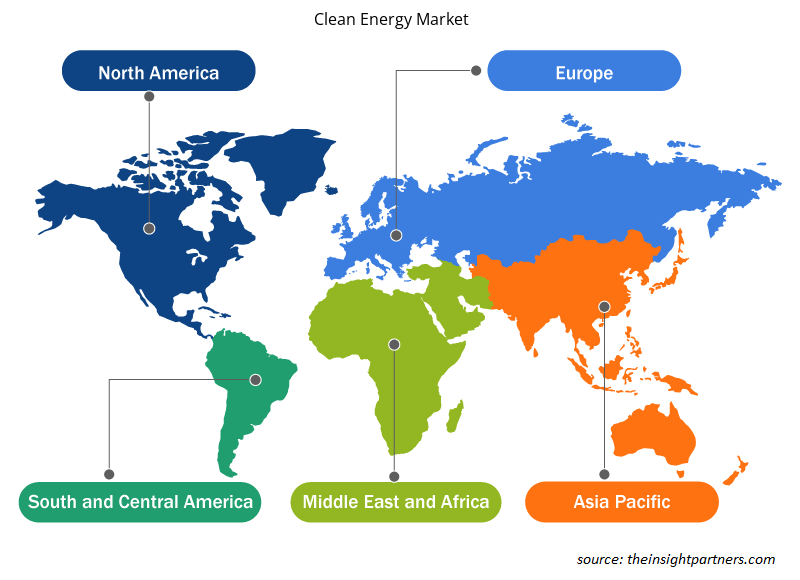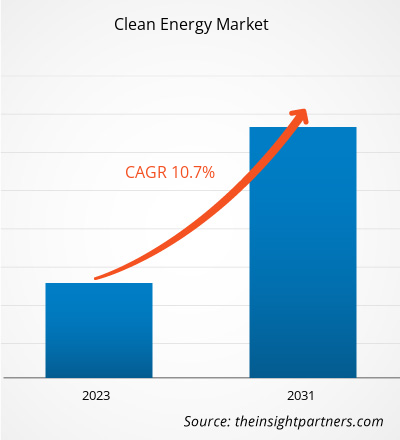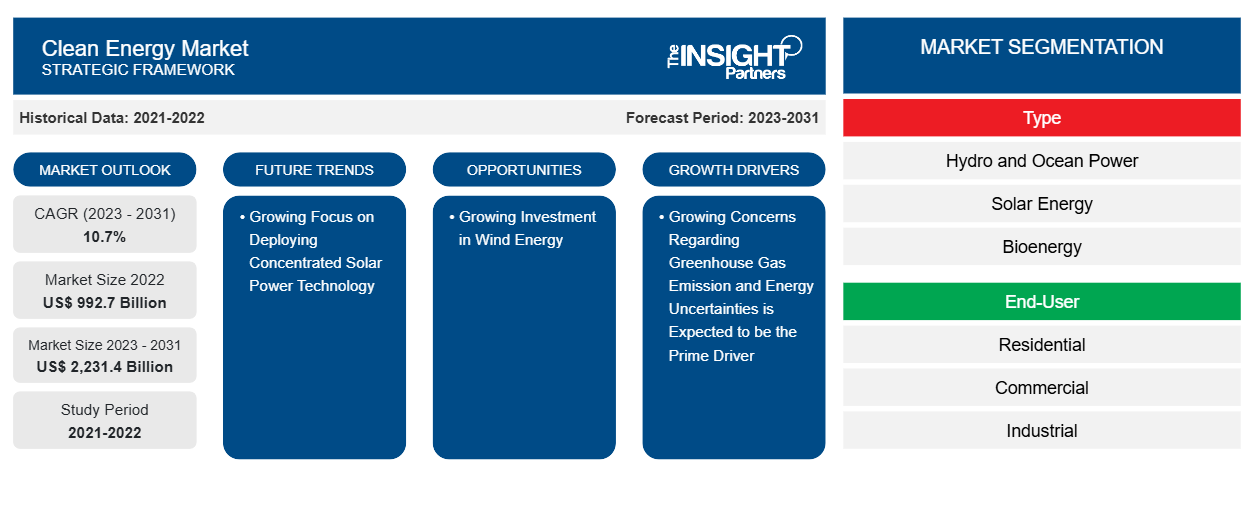Se prevé que el tamaño del mercado de energía limpia alcance los 2.231,4 mil millones de dólares en 2031, frente a los 992,7 mil millones de dólares en 2022. Se espera que el mercado registre una CAGR del 10,7 % durante el período 2023-2031. Es probable que el creciente enfoque en la reducción de las emisiones de GEI, el mayor énfasis en las fuentes de energía renovables para promover la sostenibilidad y la creciente preocupación por la protección del medio ambiente sigan siendo tendencias clave en el mercado.CAGR of 10.7% during 2023–2031. Growing focus on reducing GHG emissions, increasing emphasis on renewable energy sources for promoting sustainability, and rising concern toward environment protection are likely to remain key trends in the market.
Análisis del mercado de energía limpia
Las circunstancias energéticas cambiantes en todo el mundo están creando una demanda de fuentes de energía más sostenibles para satisfacer la creciente necesidad de energía. La creciente demanda de energía muestra la importancia de las fuentes de energía limpia. Se prevé que el aumento de los precios de la energía y las incertidumbres del suministro debido a diversos desafíos geopolíticos impulsen el crecimiento del mercado de energía limpia durante el período de pronóstico. El uso de energía limpia ayuda a reducir los efectos ambientales adversos de los recursos energéticos estándar, como el carbón y el petróleo. Por lo tanto, los gobiernos de varios países del mundo impusieron incentivos fiscales y políticas favorables para alentar la adopción de fuentes de energía limpia, que está actuando como el principal factor impulsor del mercado.
Panorama del mercado de energía limpia
Con el aumento de la población y la industrialización, la demanda de energía también está aumentando a nivel mundial. Esto ha impulsado la necesidad de fuentes de energía alternativas, ya que los recursos energéticos tradicionales, como los combustibles fósiles, están provocando contaminación ambiental. Las opciones alternativas limpias, como la solar y la eólica, reducen las enormes emisiones de carbono y su impacto negativo en el medio ambiente y ayudan a equilibrar la oferta y la demanda de energía. Por lo tanto, el aumento del desarrollo del sector de las energías renovables y las iniciativas gubernamentales de apoyo a la utilización de un enfoque sostenible para reducir las emisiones de carbono están impulsando la inversión en fuentes de energía limpia, como la eólica, la solar, la geotérmica y la hidroeléctrica.
Personalice este informe según sus necesidades
Obtendrá personalización en cualquier informe, sin cargo, incluidas partes de este informe o análisis a nivel de país, paquete de datos de Excel, así como también grandes ofertas y descuentos para empresas emergentes y universidades.
-
Obtenga las principales tendencias clave del mercado de este informe.Esta muestra GRATUITA incluirá análisis de datos, desde tendencias del mercado hasta estimaciones y pronósticos.
Factores impulsores y oportunidades del mercado de energía limpia
Crecientes preocupaciones por las emisiones de gases de efecto invernadero y la incertidumbre energética
El avance del sistema energético tras el Acuerdo de París, lanzado en 2015 y que entró en vigor en 2016, ha estimulado la utilización de fuentes de energía limpia para reducir las emisiones de carbono. Un contribuyente clave a las emisiones de gases de efecto invernadero que conducen al cambio climático es la generación de energía mediante el uso de combustibles fósiles. El empleo de fuentes de energía limpia, como la solar, la eólica, la hidroeléctrica y la geotérmica, está aumentando debido a la creciente preocupación por alternativas energéticas más sostenibles y respetuosas con el medio ambiente, las crecientes preocupaciones por el cambio climático y las iniciativas gubernamentales de apoyo para impulsar el uso de energía limpia en todo el mundo. Los gobiernos de varias economías están reconociendo la importancia de cambiar a fuentes limpias para cumplir los objetivos futuros de lograr emisiones de carbono bajas o nulas. Por ejemplo, el gobierno de los EE. UU. se ha propuesto reducir las emisiones netas de GEI en un ~50-52% en comparación con los niveles de 2005 para 2030 y alcanzar emisiones netas cero para 2050. Del mismo modo, el gobierno alemán ha fijado un objetivo de reducir sus emisiones de carbono en un ~65% en comparación con los niveles de 1990 para 2030.GHG emissions by ~50–52% compared to 2005 levels by 2030 and attain net zero emissions by 2050. Likewise, the German government has fixed a target to lower its carbon emissions by ~65% compared to 1990 levels by 2030.
Debido a la creciente incertidumbre energética en Europa a raíz de la guerra entre Rusia y Ucrania, los gobiernos de varios países han identificado la posibilidad de generar energías limpias a nivel nacional. El mercado de energía limpia incluye fuentes de energía, principalmente eólica, hidroeléctrica, geotérmica y solar. Por lo tanto, las crecientes preocupaciones con respecto a las emisiones de gases de efecto invernadero y las incertidumbres energéticas están actuando como importantes impulsores del mercado de energía limpia.
Creciente inversión en energía eólica para establecer fuentes de energía alternativas
La energía eólica, que ayuda principalmente a satisfacer la creciente demanda energética de una manera respetuosa con el medio ambiente, está surgiendo como una alternativa importante a los combustibles fósiles. Además, los gobiernos de varias naciones se están centrando en invertir en proyectos eólicos terrestres y marinos para reducir la dependencia de los combustibles fósiles y mitigar las emisiones de carbono y sus impactos tóxicos en el medio ambiente. Los proyectos eólicos marinos se consideran más eficientes que los parques eólicos terrestres debido a una mayor consistencia, velocidades del viento más altas y una falta de interferencia física de la tierra. El creciente número de proyectos eólicos marinos también está actuando como un importante factor impulsor del crecimiento del mercado de la energía limpia a nivel mundial.
Análisis de segmentación del informe del mercado de energía limpia
Los segmentos clave que contribuyeron a la derivación del análisis del mercado de energía limpia son el tipo y el usuario final.
- Según el tipo, el mercado de energía limpia se ha dividido en energía hidroeléctrica y oceánica, energía solar, bioenergía, energía geotérmica y energía eólica. El segmento de energía hidroeléctrica y oceánica tuvo la mayor participación de mercado en 2023.
- Por usuario final, el mercado se ha segmentado en residencial, comercial e industrial. El segmento residencial dominó el mercado en 2023.
Análisis de la cuota de mercado de energía limpia por geografía
El alcance geográfico del informe del mercado de energía limpia se divide principalmente en cinco regiones: América del Norte, Europa, Asia Pacífico, Medio Oriente y África, y América del Sur y Central.
En 2023, la región de Asia y el Pacífico dominó el mercado de energía limpia. El crecimiento de la población y la creciente demanda de energía son un factor impulsor importante del mercado de energía limpia en la región. Además, el creciente enfoque del gobierno en iniciar medidas y políticas de apoyo para reducir la dependencia de los combustibles fósiles y reducir las emisiones de carbono probablemente impulsará el mercado de energía limpia en la región. La creciente contaminación ambiental y los duros impactos del cambio climático son preocupaciones importantes que están estimulando la necesidad de fuentes de energía alternativa limpia para reducir la utilización de combustibles fósiles. Por ejemplo, la Agencia de Desarrollo de Energía Renovable de la India ofrece préstamos a bajo interés para desarrollar proyectos de energía renovable elegibles en el país. La India se ha propuesto lograr que el 50% de la energía eléctrica acumulada instalada para 2030 provenga de energías renovables y emisiones netas de carbono cero para 2070. Además, en 2022, el gobierno presentó un plan de acción "Misión 500GW" para alcanzar el objetivo general de energía renovable.renewables and net-zero carbon emissions by 2070. Moreover, in 2022, the government introduced a "Mission 500GW" action plan to attain the overall renewable target.
Perspectivas regionales sobre el mercado de energía limpia
Los analistas de Insight Partners explicaron en detalle las tendencias y los factores regionales que influyen en el mercado de energía limpia durante el período de pronóstico. En esta sección también se analizan los segmentos y la geografía del mercado de energía limpia en América del Norte, Europa, Asia Pacífico, Oriente Medio y África, y América del Sur y Central.

- Obtenga los datos regionales específicos para el mercado de energía limpia
Alcance del informe sobre el mercado de energía limpia
| Atributo del informe | Detalles |
|---|---|
| Tamaño del mercado en 2022 | US$ 992,7 mil millones |
| Tamaño del mercado en 2031 | US$ 2.231,4 mil millones |
| CAGR global (2023 - 2031) | 10,7% |
| Datos históricos | 2021-2022 |
| Período de pronóstico | 2023-2031 |
| Segmentos cubiertos |
Por tipo
|
| Regiones y países cubiertos |
América del norte
|
| Líderes del mercado y perfiles de empresas clave |
|
Densidad de actores del mercado de energía limpia: comprensión de su impacto en la dinámica empresarial
El mercado de energía limpia está creciendo rápidamente, impulsado por la creciente demanda de los usuarios finales debido a factores como la evolución de las preferencias de los consumidores, los avances tecnológicos y una mayor conciencia de los beneficios del producto. A medida que aumenta la demanda, las empresas amplían sus ofertas, innovan para satisfacer las necesidades de los consumidores y aprovechan las tendencias emergentes, lo que impulsa aún más el crecimiento del mercado.
La densidad de actores del mercado se refiere a la distribución de las empresas o firmas que operan dentro de un mercado o industria en particular. Indica cuántos competidores (actores del mercado) están presentes en un espacio de mercado determinado en relación con su tamaño o valor total de mercado.
Las principales empresas que operan en el mercado de energía limpia son:
- Compañía: Xcel Energy Inc.
- EDF Energía
- Siemens Energy AG
- Enel SpA
- Andritz AG
Descargo de responsabilidad : Las empresas enumeradas anteriormente no están clasificadas en ningún orden particular.

- Obtenga una descripción general de los principales actores clave del mercado de energía limpia
Noticias y desarrollos recientes del mercado de energía limpia
El mercado de energía limpia se evalúa mediante la recopilación de datos cualitativos y cuantitativos a partir de investigaciones primarias y secundarias, que incluyen importantes publicaciones corporativas, datos de asociaciones y bases de datos. A continuación se enumeran algunos de los avances en el mercado de energía limpia:
- Canadian Solar Inc. anunció que el gobierno municipal de la ciudad de Yangzhou, en la provincia de Jiangsu, China, firmó un acuerdo de inversión plurianual con su subsidiaria de propiedad mayoritaria, CSI Solar Co Ltd. Según el acuerdo, CSI Solar planea expandir la capacidad del parque industrial de fabricación de energía limpia de Yangzhou para fabricar obleas, celdas y módulos de alta eficiencia integrados verticalmente, así como sistemas de baterías. (Fuente: Comunicado de prensa/Sitio web de la empresa/Boletín informativo, enero de 2023)
- Composites, Inc. (TPI) (Nasdaq: TPIC), una empresa global que se centra en soluciones innovadoras y sostenibles, anunció que ha renovado sus acuerdos de suministro con GE Renewable Energy hasta 2025. GE y TPI también están trabajando en estrategias para trabajar juntos en los tipos de palas de próxima generación de GE, incluida la posibilidad de sumar más líneas de producción en 2023, además de las nueve líneas de producción que GE tiene en funcionamiento con TPI. (Fuente: Comunicado de prensa/Sitio web de la empresa/Boletín informativo, enero de 2023)
Informe sobre el mercado de energía limpia: cobertura y resultados
El informe "Tamaño y pronóstico del mercado de energía limpia (2021-2031)" proporciona un análisis detallado del mercado que cubre las siguientes áreas:
- Tamaño del mercado de energía limpia y pronóstico a nivel mundial, regional y nacional para todos los segmentos clave del mercado cubiertos bajo el alcance
- Tendencias del mercado de energía limpia, así como dinámicas del mercado, como impulsores, restricciones y oportunidades clave
- Análisis detallado de las cinco fuerzas de Porter y PEST y FODA
- Análisis del mercado de energía limpia que abarca las tendencias clave del mercado, el marco global y regional, los principales actores, las regulaciones y los desarrollos recientes del mercado
- Análisis del panorama de la industria y de la competencia que abarca la concentración del mercado, el análisis de mapas de calor, los actores destacados y los desarrollos recientes del mercado de energía limpia
- Perfiles detallados de empresas
- Análisis histórico (2 años), año base, pronóstico (7 años) con CAGR
- Análisis PEST y FODA
- Tamaño del mercado, valor/volumen: global, regional y nacional
- Industria y panorama competitivo
- Conjunto de datos de Excel
Informes recientes
Testimonios
Razón para comprar
- Toma de decisiones informada
- Comprensión de la dinámica del mercado
- Análisis competitivo
- Información sobre clientes
- Pronósticos del mercado
- Mitigación de riesgos
- Planificación estratégica
- Justificación de la inversión
- Identificación de mercados emergentes
- Mejora de las estrategias de marketing
- Impulso de la eficiencia operativa
- Alineación con las tendencias regulatorias























 Obtenga una muestra gratuita para - Mercado de energía limpia
Obtenga una muestra gratuita para - Mercado de energía limpia